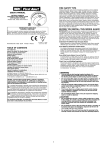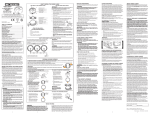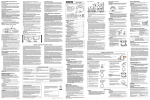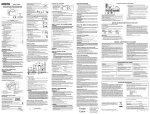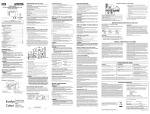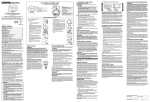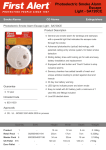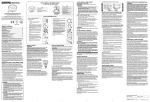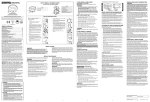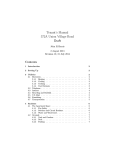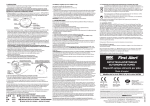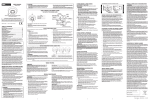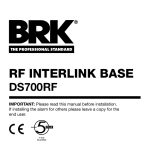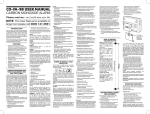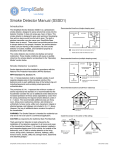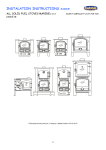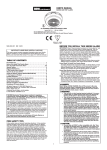Transcript
THE PARTS OF THIS SMOKE ALARM USER’S MANUAL BATTERY POWERED PHOTOELECTRIC SMOKE ALARM WITH SILENCE AND/OR ESCAPE LIGHT® AND/OR INTERCONNECT FEATURES 3. Power indicator light and alarm indicator 1. Hold base firmly and twist the mounting bracket counterclockwise to separate it from the base. 4. SA720CE ONLY: Escape Light® 2. Hold the mounting bracket against the ceiling (or wall) so the vertical mounting slot is aligned in the 12 o’clock position and trace around the inside of the mounting slots (vertical and horizontal mounting). 3. Put the unit where it won’t get covered with dust when you drill the mounting holes. Models SA710CE SA710LCE SA720CE: 08 1134-CPD-035 EN 14604:2005 2. Battery drawer If you want to lock the battery drawer, or lock the Smoke Alarm to the mounting bracket, please read the “Optional Locking Features” section before you begin installation. 1. Test/Silence button IMPORTANT! PLEASE READ CAREFULLY AND SAVE. This user’s manual contains important information about your Smoke Alarm’s operation. If you are installing this Smoke Alarm for use by others, you must leave this manual— or a copy of it—with the end user. Models 710E 710IE 710LE: FOLLOW THESE SIMPLE STEPS! 4. Using a 5 mm (3/16”) drill bit, drill a hole through the center of the oval outlines you traced. 1. Mounting bracket 08 1134-CPD-036 EN 14604:2005 2. Mounting slots 3. Battery drawer, install 9V battery here 4. Turn this way to remove from bracket M09-0017-020 K1 04/09 Printed in Mexico 5. Turn this way to attach to bracket TABLE OF CONTENTS Fire Safety Tips . . . . . . . . . . . . . . . . . . . . . . . . . . . . . . . . . . . . . . . . . . .1 Before You Install This Smoke Alarm . . . . . . . . . . . . . . . . . . . . . . . . .1 How To Install This Smoke Alarm . . . . . . . . . . . . . . . . . . . . . . . . . .2-3 Optional Locking Features . . . . . . . . . . . . . . . . . . . . . . . . . . . . . . . .2-3 Weekly Testing . . . . . . . . . . . . . . . . . . . . . . . . . . . . . . . . . . . . . . . . . . .4 Regular Maintenance . . . . . . . . . . . . . . . . . . . . . . . . . . . . . . . . . . . . . .4 If This Smoke Alarm Sounds . . . . . . . . . . . . . . . . . . . . . . . . . . . . . . . .4 What To Do In Case Of Fire . . . . . . . . . . . . . . . . . . . . . . . . . . . . . . . . .4 Using the Silence Feature . . . . . . . . . . . . . . . . . . . . . . . . . . . . . . . . . .4 If You Suspect A Problem . . . . . . . . . . . . . . . . . . . . . . . . . . . . . . . . . .4 Limited Guarantee . . . . . . . . . . . . . . . . . . . . . . . . . . . . . . . . . . . . . . . .5 Recommended Locations For Smoke Alarms . . . . . . . . . . . . . . . . .5 Locations To Avoid For Smoke Alarms . . . . . . . . . . . . . . . . . . . . . . .5 About Smoke Alarms . . . . . . . . . . . . . . . . . . . . . . . . . . . . . . . . . . . .5-6 Special Compliance Considerations . . . . . . . . . . . . . . . . . . . . . . . . .6 Limitations Of Smoke Alarms . . . . . . . . . . . . . . . . . . . . . . . . . . . . . . .6 All BRK® and First Alert® Smoke Alarms conform to regulatory requirements, including EN14604:2005 and are designed to detect particles of combustion. Smoke particles of varying number and size are produced in all fires. TOOLS YOU WILL NEED: NOTE: After you install the battery, the power indicator light may flash. (If the unit alarms, the light will blink rapidly, and the horn will repeatedly sound beep, beep, beep...) This unit is designed to be mounted on the ceiling, or on the wall if necessary. • Pencil 8. Attach the Smoke Alarm to the mounting bracket. Line up the guides on the alarm’s base with the guides on the mounting bracket. When guides are lined up, turn the base clockwise (right) until it snaps into place. • Drill with 5 mm (3/16”) drill bit • Standard flathead screwdriver NOTE: Once the Smoke Alarm is snapped onto the mounting bracket, you can rotate the Smoke Alarm to adjust the alignment. • Hammer • Pliers or utility knife, to activate optional “tamper-resistant” locking features 9. Test the Smoke Alarm. See “Weekly Testing.” HOW TO INTERCONNECT ALARMS (Model 710IE Only) Up to 12 Smoke Alarms may be interconnected so that if one Alarm senses smoke, all the Alarms will sound an alarm. Low battery warning will sound only in an Alarm that needs a new battery, however. The wiring must conform to current IEE regulations for electrical installations. Connect the alarms together by connecting all the SIGNAL terminals to each other and all GROUND terminals to each other. See figure. Use twin core 0.75mm2 multi-strand or larger twin-core cable. IMPORTANT! Read “Recommended Locations for Smoke Alarms” and “Locations to Avoid for Smoke Alarms” before beginning. This unit monitors the air, and when smoke reaches its sensing chamber, it alarms. It can give you more time to escape before fire spreads. This unit can ONLY give an early warning of developing fires if it is installed, maintained and located where smoke can reach it, and where all residents can hear it, as described in this manual. This unit will not sense gas, heat, or flame. It cannot prevent or extinguish fires. Understand The Different Type of Smoke Alarms Battery powered or mains powered? Different Smoke Alarms provide different types of protection. See “About Smoke Alarms” for details. Know Where To Install Your Smoke Alarms Fire Safety Professionals recommend at least one Smoke Alarm on every level of your home, in every bedroom, and in every bedroom hallway or separate sleeping area. See “Recommended Locations For Smoke Alarms” and “Locations To Avoid For Smoke Alarms” for details. If the Smoke Alarms are not going to be interconnected to other Alarms, simply do not use the SIGNAL and GROUND terminals provided for interconnection. SIGNAL SIGNAL GROUND GROUND The optional locking features are designed to discourage unauthorized removal of the battery or Alarm. It is not necessary to activate the locks in single-family households where unauthorized battery or Alarm removal is not a concern. These Smoke Alarms have two separate locking features: one to lock the battery compartment, and the other to lock the Smoke Alarm to the mounting bracket. You can choose to use either feature independently, or use them both. This Smoke Alarm has a battery guard which resists closing unless a battery is installed. This warns you the unit will not operate without a battery. • Do not install the Alarm where it may be exposed to dripping water or could be splashed. • Do not install this unit over a mains cable junction box or holes in the ceiling. Air currents can prevent smoke from reaching the sensing chamber and prevent the unit from alarming. Only mains (AC) powered units are intended for installation over mains cables. • • • If the Smoke Alarm becomes contaminated by excessive dirt, dust and/or grime, and cannot be cleaned to avoid unwanted alarms, replace the unit immediately. Relocate the unit if it sounds frequent unwanted alarms. See “Locations to Avoid For Smoke Alarms” for details. When the battery becomes weak, the Smoke Alarm unit will “chirp” about once a minute (the low battery warning). This low battery warning should last for 30 days, but you should replace the battery immediately to continue your protection. • • • Test for proper Smoke Alarm operation using the test button whenever the battery is replaced. Choosing a replacement battery: Your Smoke Alarm requires a standard 9V battery. The following batteries are acceptable as replacements: Duracell #MN1604, Energizer #522. You may also use the Ultralife U9VL-J lithium battery for longer service life between battery changes. These batteries are available at many local retail stores. When using a lithium battery there is a danger of explosion if the battery is incorrectly replaced. Replace a lithium battery only with the same or equivalent type. Most zinc carbon batteries have an average service life of 1 year; most alkaline batteries have an average service life of 1-2 years; most Lithium batteries have an average service life of 6-10 years. Actual battery service life depends on the Smoke Alarm and the environment in which it is installed. All the batteries specified above are acceptable replacement batteries for this unit. Regardless of the manufacturer’s suggested battery life, you MUST replace the battery immediately once the unit starts “chirping” (the “low battery warning”). • If the unit alarms and you are not testing the unit, it is warning you of a potentially dangerous situation that requires your immediate attention. NEVER ignore any alarm. Ignoring the alarm may result in injury or death. Never remove the batteries from a battery operated Smoke Alarm to stop an unwanted alarm (caused by cooking smoke, etc.). Removing batteries disables the alarm so it cannot sense smoke, and removes your protection. Instead open a window or fan the smoke away from the unit. The alarm will reset automatically. • Cover your nose and mouth with a cloth (preferably damp). Take short, shallow breaths. • Meet at your planned meeting place outside your home, and do a head count to make sure everybody got out safely. • Call the Fire Brigade as soon as possible from outside. Give your address, then your name. Never go back inside a burning building for any reason. Contact your Fire Brigade for ideas on making your home safer. TO UNLOCK THE BATTERY COMPARTMENT • • Alarms have various limitations. See "Limitations of Smoke Alarms" for details. USING THE SILENCE FEATURE The Silence Feature can temporarily quiet an unwanted alarm for up to 15 minutes. To use this feature, press the “Push to Test/Silence” button on the cover. If the unit will not silence and no heavy smoke is present, or if it stays in silence mode continuously, it should be replaced immediately. The LED will flash every 10 seconds while in silence. The Silence Feature does not disable the unit—it makes it temporarily less sensitive to smoke. For your safety, if smoke around the unit is dense enough to suggest a potentially dangerous situation, the unit will stay in alarm or may re-alarm quickly. If you do not know the source of the smoke, do not assume it is an unwanted alarm. Not responding to an alarm can result in property loss, injury, or death. 4. Reattach the Smoke Alarm to the mounting bracket. 4. Push the locking pin through the hole near the battery door latch on the back of the Smoke Alarm. When replacing the battery, always test the Smoke Alarm before relocking the battery compartment. TO LOCK THE MOUNTING BRACKET TO UNLOCK THE MOUNTING BRACKET 1. Using needle-nose pliers or a utility knife, detach one locking pin from the mounting bracket. 1. Insert a flathead screwdriver between the mounting bracket pin and the mounting bracket. IF YOU SUSPECT A PROBLEM 2. Insert the locking pin through the hole on the back of the Smoke Alarm as shown in the diagram. 2. Pry the Smoke Alarm away from the bracket by turning both the screwdriver and the Smoke Alarm counterclockwise (left) at the same time. 3. When you attach the Smoke Alarm to the mounting bracket, the locking pin’s head will fit into a notch on the bracket. Smoke Alarms may not operate properly because of dead, missing or weak batteries, a build-up of dirt, dust or grease on the Smoke Alarm cover, or installation in an improper location. Clean the Smoke Alarm as described in “Regular Maintenance,” and install a fresh battery, then test the Smoke Alarm again. If it fails to test properly when you use the test button, or if the problem persists, replace the Smoke Alarm immediately. • If you hear a “chirp” once a minute, replace the battery. • If you experience frequent non-emergency alarms (like those caused by cooking smoke), try relocating the Smoke Alarm. • If the alarm sounds when no smoke is visible, try cleaning or relocating the Smoke Alarm. The Alarm may be dirty or dusty. • If the alarm does not sound during testing, try installing a new battery, and make sure it is snapped in securely. • Do not paint over the unit. Paint may clog the openings to the sensing chamber and prevent the unit from operating properly. 2 Evelyn Colon Digitally signed by Evelyn Colon Date: 2009.04.09 15:49:30 -05'00' ® Model SA720CE only: The Escape Light bulb is not replaceable. In the unlikely event that the Escape Light® does not operate during testing, please obtain guarantee service. Do not try fixing the alarm yourself – this will void your warranty! If the Smoke Alarm is still not operating properly, and it is still under guarantee, please see “How to Obtain Guarantee Service” in the Limited Guarantee. 3 BEDROOM LIVING ROOM LOUNGE KITCHEN SINGLE-STORY RESIDENCE, FLAT, MOBILE HOME MULTI-STORY RESIDENCE KEY: DINING ROOM BEDROOM REQUIRED TO MEET BSI RECOMMENDATIONS RECOMMENDED FOR ADDITIONAL PROTECTION Smoke Alarms shall be installed in all circulation spaces (normally hallways and staircases) that form part of escape routes, one on every level, and in all rooms and areas that present a high fire risk. Additionally, Smoke Alarms should also be installed between the sleeping area(s) and the most likely sources of fire (living room and kitchen). If there are long hallways, corridors, or protected rooms or areas over 7.5 metres (25 feet) from the nearest unit, the installation of additional Smoke Alarms may be necessary. Areas containing stored combustibles or sources of ignition may also warrant the installation of additional Smoke Alarms. The installation of Smoke Alarms in kitchens, toilets, bathrooms or shower rooms is not recommended, as these locations occasionally experience conditions that can result in improper operation. LOCATIONS TO AVOID FOR SMOKE ALARMS WHAT TO DO IN CASE OF FIRE Feel doors with the back of your hand before opening them. If a door is cool, open it slowly. Don’t open a hot door. Keep doors and windows closed, unless you must escape through them. 3. To relock the battery compartment, close the battery door and reinsert locking pin in lock. HALL If the unit alarms get everyone out of the house immediately. • 2. Insert a flathead screwdriver under the head of the locking pin, and gently pry it out of the battery compartment lock. (If you plan to relock the battery compartment, save the locking pin.) KITCHEN BEDROOM RESPONDING TO AN ALARM To permanently remove either locking pin, insert a flathead screwdriver between the locking pin and the lock, and pry the pin out of the lock. 1. Install the battery so the terminals on the battery match the terminals on the Smoke Alarm. Match “+” to “+” and “-” to “-.” Push the battery in until it snaps in securely and cannot be shaken loose. If the battery is not snapped in completely, the unit cannot receive battery power. BEDROOM BS 5839 Part 6 (Code of practice for the design and installation of fire detection and alarm systems in dwellings) Get out of the house as quickly as possible. Don’t stop to get dressed or collect anything. 1. Remove the Smoke Alarm from the mounting bracket. If the unit is locked to the bracket, see the section “To Unlock the Mounting Bracket.” Specific requirements for Smoke Alarm installation may vary from region to region. Check with your local Fire Brigade and Building Control for current requirements in your area. ABOUT SMOKE ALARMS, Continued All these Smoke Alarms are designed to provide early warning of fires if located, installed and cared for as described in the user’s manual, and if smoke reaches them. If you are unsure which type of Smoke Alarm to install, refer to British Standard (BS) 5839 Part 6 and 5588 Part 1. BSI, 389 Chiswick High Road, London, W4 4AL, UK. Local building regulations may also require specific units in new construction or in different areas of the home. SPECIAL COMPLIANCE CONSIDERATIONS This Smoke Alarm alone is not a suitable substitute for complete fire detection systems in places housing many people—like blocks of flats (communal escape routes), hotels, motels, hostels, inns, hospitals, long-term health care facilities, nursing homes, day care facilities, boarding houses or sheltered housing of any kind—even if they were once single-family residences. It is not a suitable substitute for complete fire detection systems in warehouses, industrial facilities, commercial buildings, and special-purpose non-residential buildings which require special fire detection and alarm systems. Depending on the building regulations in your area, this Smoke Alarm may be used to provide additional protection in these facilities. The following information applies to all four building types below: In new construction, most building regulations require the use of mains (AC) or mains powered with integral standby supply (AC/DC) Smoke Alarms only. In existing construction, mains powered (AC), mains powered with integral standby supply (AC/DC), or battery (DC) powered Smoke Alarms can be used as specified by local building regulations. Refer to British Standard BS 5839 Part 6 and BS 5588 Part 1, local buildings regulations, or consult your Fire Brigade for detailed fire protection requirements in buildings not defined as “dwellings.” 1. Single-Family Residence: Single family home. It is recommended Smoke Alarms be installed in all circulation spaces (normally hallways and staircases) that form part of escape routes, on every level, in all rooms and areas that present a high fire risk and between the sleeping area(s) and the most likely sources of fire (living room and kitchen). 2. Multi-Family or Mixed Occupant Residence: Blocks of flats. This Smoke Alarm is suitable for use in individual flats, provided a primary fire detection system already exists to meet fire detection requirements in common areas like foyers, hallways, corridors, or porches. Using this Smoke Alarm in common areas may not provide sufficient warning to all residents or meet local fire protection by-laws/ regulations. 3. Institutions: Hospitals, day care facilities, long-term health care facilities. This Smoke Alarm may be suitable for use in individual patient sleeping/resident rooms, provided a primary fire detection system already exists to meet fire detection requirements in common areas like foyers, hallways, corridors, or porches. Using this Smoke Alarm in common areas may not provide sufficient warning to all residents or meet local fire protection by-laws/regulations. 4. Hotels and Motels: Also hostels, inns, boarding houses and sheltered housing. This Smoke Alarm may be suitable for use inside individual sleeping/resident rooms, provided a primary fire detection system already exists to meet fire detection requirements in common areas like foyers, hallways, corridors, or porches. Using this Smoke Alarm in common areas may not provide sufficient warning to all residents or meet local fire protection by-laws/ regulations. LIMITATIONS OF SMOKE ALARMS • Do not lock the battery compartment until you activate the battery and test the Smoke Alarm. Installing Smoke Alarms in Single-Family Residences Please conform to national/regional standards and regulations. The building code requires one Smoke Alarm on every floor, and recommends one in every living area, and in every bedroom or sleeping area. In new construction, the Smoke Alarms must be mains (AC) powered. See “British Standards (BSI) Recommendations” for details. For additional coverage, it is recommended that you also install a Smoke Alarm in halls, storage areas, and finished attics. Make sure no door or other obstruction could keep smoke from reaching the Smoke Alarms or minimize the sound level produced from ensuring the occupants from hearing the alarm signal. More specifically, install Smoke Alarms: • Where temperatures normally remain between 4˚ C (40˚ F) and 38˚ C (100˚ F). • On every level of your home, including finished attics. • Inside every bedroom, especially if people sleep with doors closed. • In the hall near every sleeping area. If your home has multiple sleeping areas, install a unit in each. If a hall is over 7.5 metres (25 feet) long, install an alarm at each end. • At the top of the first-to-second floor and subsequent floor stairways, and at the bottom of the ground floor stairway. BRITISH STANDARDS (BSI) RECOMMENDATIONS Both locking features use locking pins, which are molded into the mounting bracket. Using needle-nose pliers or a utility knife, remove one or both pins from the mounting bracket, depending on how many locking features you want to use. TO LOCK THE BATTERY COMPARTMENT RECOMMENDED LOCATIONS FOR SMOKE ALARMS IF THIS SMOKE ALARM SOUNDS Don’t panic; stay calm. Follow your family escape plan. Do not stand too close to the unit when the alarm is sounding. It is loud to wake you in an emergency. Exposure to the horn at close range may harm your hearing. 1 Clean the Smoke Alarm at least once a month; gently vacuum the outside of the Smoke Alarm using your household vacuum’s soft brush attachment. Test the Smoke Alarm. Never use water, cleaners or solvents since they may damage the unit. • • • • Tools you will need: • Needle-nose pliers or utility knife • Standard Flathead screwdriver. 3. Using needle-nose pliers or a utility knife, detach one locking pin from the mounting bracket. Unit will not operate without battery power. The Smoke Alarm cannot work until you install the battery in the correct position (Match “+” to “+” and “-” to “-”). Use only the replacement batteries listed below. The unit may not operate properly with other batteries. Never use rechargeable batteries since they may not provide a constant charge. • Test your Alarm at least once a week. OPTIONAL LOCKING FEATURES If the unit does not alarm during testing, DO NOT lock the battery compartment! Install a new battery and test again. If the Smoke Alarm still does not alarm, replace it immediately. • This unit has been designed to be as maintenance free as possible, but there are a few simple things you must do to keep it working properly. • Check Your Local Building Regulations This Smoke Alarm is designed to be used in a typical single-family residence. It alone may not meet requirements for boarding houses, sheltered housing, hotels, motels, hostels, inns or communal escape routes in blocks of flats. See “Special Compliance Considerations” for details. Do not connect this unit to any other alarm or auxiliary device. It is a single-station unit that cannot be linked to other devices. Connecting anything else to this unit may prevent it from working properly. REGULAR MAINTENANCE • TO OTHER INTERCONNECTED ALARMS (MAXIMUM OF 12) 2. Push and hold Test/Silence button until the alarm sounds: beep, beep, beep... • It is important to test this unit every week to make sure it is working properly. Using the test button is the recommended way to test this Smoke Alarm. Press and hold the test button on the cover of the unit until the alarm sounds (the unit may continue to alarm for a few seconds after you release the button). If it does not alarm, make sure the unit is receiving power (LED will flash approximately once a minute indicating it has power); and test it again. If it still does not alarm, replace it immediately. During testing you will hear a loud, repeating horn pattern: beep, beep, beep... Model SA720CE only: The Escape Light® will turn on. During an alarm, you will hear a loud, repeating horn pattern: beep, beep, beep... The LED will flash rapidly. Model SA720CE only: The Escape Light® will turn on. MAXIMUM INTERCONNECT WIRE LENGTH: 150 METRES (500 FEET) Know What Smoke Alarms Can and Can’t Do A Smoke Alarm can help alert you to fire, giving you precious time to escape. It can only sound an alarm once smoke reaches the sensor. See “Limitations of Smoke Alarms” for details. This unit will not alert hearing impaired residents. It is recommended that you install special units which use devices like flashing strobe lights to alert hearing impaired residents. After you interconnect the Alarms, push the test button on one Alarm. The alarm horns on all the Alarms should sound if they are connected properly. } BEFORE YOU INSTALL THIS SMOKE ALARM Smoke Alarms should be interconnected within one family residence only. If Smoke Alarms are interconnected between residences, nuisance alarms will occur when an alarm in another residence is tested. This Smoke Alarm is not designed to be connected to anything except other Model 710IE Alarms. Connecting any other Alarm or auxiliary device to these alarms will keep them from working properly. Photoelectric technology is generally more sensitive than ionisation technology at detecting large particles, which tend to be produced in greater amounts by smouldering fires, which may smoulder for hours before bursting into flame. Sources of these fires may include cigarettes burning in couches or bedding. Follow safety rules and prevent hazardous situations: 1) Use smoking materials properly. Never smoke in bed. 2) Keep matches or lighters away from children; 3) Store flammable materials in proper containers; 4) Keep electrical appliances in good condition and don’t overload mains circuits; 5) Keep cookers, barbecue grills, fireplaces and chimneys grease- and debris-free; 6) Never leave anything heating on the cooker unattended; 7) Keep portable heaters and open flames, like candles, away from flammable materials; 8) Don’t let rubbish accumulate. Keep alarms clean, and test them weekly. Replace alarms immediately if they are not working properly. Smoke Alarms that do not work cannot alert you to a fire. Keep at least one working fire extinguisher on every floor, and an additional one in the kitchen along with a fire blanket. Have fire escape ladders or other reliable means of escape from an upper floor in case stairs are blocked. 7. Install the battery (included). Open the battery drawer. Match the terminals on the end of the battery with the terminals on the unit. Match “+” to “+” and “-” to “-.” Push the battery in until it snaps in securely and cannot be shaken loose. If the battery is not snapped in completely, the unit cannot receive battery power. Or, activate the battery back-up by removing the “Pull to Activate Battery Back-Up” tab. Ionisation technology is generally more sensitive than photoelectric technology at detecting small particles, which tend to be produced in greater amounts by flaming fires, which consume combustible materials rapidly and spread quickly. Sources of these fires may include paper burning in a wastebasket, or a grease fire in the kitchen. FIRE SAFETY TIPS 6. Attach the mounting bracket to the ceiling or wall. NEVER use an open flame of any kind to test this unit. You might accidentally damage or set fire to the unit or to your home. The built-in test switch accurately tests the unit’s operation. BRK Brands Europe Ltd., (“the Company”), guarantees its enclosed Smoke Alarm – but not the battery – to be free from defects in materials and workmanship under normal use and service for a period of ten years from the date of purchase. BRK Brands Europe Ltd. makes no other express guarantee for this Smoke Alarm. No agent, representative, dealer or employee of the Company has the authority to increase or alter the obligations or limitations of the Guarantee. The Company’s obligation of this Guarantee shall be limited to the repair or replacement of any part of the alarm which is found to be defective in materials or workmanship under normal use and service during the ten year period commencing with date of purchase. The Company shall not be obligated to repair or replace alarms which are found to be in need of repair because of damage, unreasonable use, modifications or alterations occurring after the date of purchase. How to Obtain Guarantee Service Service: If service is required return the product to your retailer. Battery: BRK Brands Europe Ltd. make no guarantee, express or implied, written or oral, including that of merchantability or fitness for any particular purpose with respect to battery. BATTERY POWERED © 2009 BRK Brands Europe Ltd Unit 6, Carter Court, Davy Way, Waterwells Business Park Quedgeley, Gloucester GL2 2DE United Kingdom All rights reserved. E-mail address: [email protected] • [email protected] www.brkdicon.eu • www.firstalert.eu 5. Insert the plastic screw anchors (in the plastic bag with screws) into the holes. Tap the screw anchors gently with a hammer, if necessary, until they are flush with the ceiling or wall. LIMITED GUARANTEE EXISTING HOMES WEEKLY TESTING HOW TO INSTALL THIS SMOKE ALARM 4 For best performance, it is recommended you AVOID installing Smoke Alarms in these areas: • Where combustion particles are produced. Combustion particles form when something burns. Areas to avoid include kitchens, garages, and boiler rooms. Keep units at least 3 metres (10 feet) from the sources of combustion particles (cooker, boiler, space heater) 6 metres (20 feet) if possible. Ventilate these areas as much as possible. Note: If you must install Smoke Alarms closer than 6 metres (20 feet) from a source of combustion particles, keep the area well ventilated, and the Smoke Alarms clean. • In air streams near kitchens. Air currents can draw cooking smoke into the sensing chamber of a Smoke Alarm near the kitchen. • In very damp, humid or steamy areas keep units at least 3 metres (10 feet) away from bathrooms, toilets, showers, dishwashers, etc. • Where the temperatures are regularly below 4˚ C (40˚ F) or above 38˚ C (100˚ F), including unheated buildings, outdoor rooms, or porches. • In very dusty, dirty, or greasy areas. Do not install a Smoke Alarm directly over the cooker. Keep laundry room Smoke Alarms free of dust or lint. • Near fresh air vents, ceiling fans, or in very drafty areas. Drafts can blow smoke away from the unit, preventing it from reaching the sensing chamber. • In insect infested areas. Insects can clog openings to the sensing chamber and cause unwanted alarms. • Less than 300 mm (12 inches) away from light fittings. Electrical “noise” can interfere with the sensor; i.e. fluorescent lights, etc. • Where the bottom edge of wall mounted Smoke Alarms is placed below the level of any door opening. • In rooms which are being decorated, painted or artexed. • In “dead air” spaces. “Dead air” spaces may prevent smoke from reaching the Smoke Alarm. Avoiding Dead Air Spaces “Dead air” spaces may prevent smoke from reaching the Smoke Alarm. To avoid dead air spaces, follow the installation recommendations below. On ceilings, install Smoke Alarms as close to the centre of the ceiling as possible. If this is not possible, install the Smoke Alarm at least 300 mm (12 inches) from the wall or corner. For wall mounting (if allowed by building regulations), the top edge of Smoke Alarms should be placed between 150 and 300 mm (6 and 12 inches) from the wall/ceiling line, below typical “dead air” spaces. On a peaked, gabled, or cathedral ceiling, install the first Smoke Alarm within 0.9 metres (3 feet) of the peak of the ceiling, measuring horizontally. Additional Smoke Alarms may be required depending on the length, angle, etc. of the ceiling's slope. Refer to BS 5839 Part 6, 5588 Part 1 and local building regulations for details on requirements for sloped or peaked ceilings. Smoke Alarms have played a key role in reducing deaths resulting from home fires worldwide. However, like any warning device, Smoke Alarms can only work if they are properly located, installed, and maintained, and if smoke reaches them. They are not foolproof. Smoke Alarms may not waken all individuals. Practice the escape plan at least twice a year, making sure that everyone is involved – from kids to grandparents. Allow children to master fire escape planning and practice before holding a fire drill at night when they are sleeping. If children or others do not readily waken to the sound of the Smoke Alarm, or if there are infants or family members with mobility limitations, make sure that someone is assigned to assist them in fire drill and in the event of an emergency. It is recommended that you hold a fire drill while family members are sleeping in order to determine their response to the sound of the Smoke Alarm while sleeping and to determine whether they may need assistance in the event of an emergency. Smoke Alarms cannot work without power. Battery operated units cannot work if the batteries are missing, disconnected or dead, if the wrong type of batteries are used, or if the batteries are not installed orrectly. AC units cannot work if the AC power is cut off for any reason (open fuse or circuit breaker, failure along an electrical mains or at a power station, electrical fire that burns the electrical wires, etc.). If you are concerned about the limitations of battery or AC power, install both types of units. Smoke Alarms cannot detect fires if the smoke does not reach them. Smoke from fires in chimneys or walls, on roofs, or on the other side of closed doors may not reach the sensing chamber and set off the alarm. That is why one unit should be installed inside each bedroom or sleeping area—especially if bedroom or sleeping area doors are closed at night—and in the hallway between them. Smoke Alarms may not detect fire on another floor or area of the home. For example, a stand-alone unit on the second floor may not detect smoke from a ground floor fire until the fire spreads. This may not give you enough time to escape safely. That is why recommended minimum protection is at least one unit in all circulation spaces (normally hallways and staircases) that form part of escape routes, on every level, and in all rooms and areas that present a high fire risk. Even with a unit on every floor, stand-alone units may not provide as much protection as interconnected units, especially if the fire starts in a remote area. Some safety experts recommend installing interconnected mains (AC) powered units with battery (DC) back-up (see “About Smoke Alarms”) or professional fire detection systems, so if one unit senses smoke, all units alarm. Interconnected units may provide earlier warning than stand-alone units since all units alarm when one detects smoke. Smoke Alarms may not be heard. Though the alarm horn in this unit meets or exceeds current Standards, it may not be heard if: 1) the unit is located outside a closed or partially closed door, 2) residents recently consumed alcohol or drugs, 3) the alarm is drowned out by noise from stereo, TV, traffic, air conditioner or other appliances, 4) residents are hearing impaired or sound sleepers. Special purpose units, like those with visual and audible alarms, etc. should be installed for hearing impaired residents. Smoke Alarms may not have time to alarm before the fire itself causes damage, injury, or death, since smoke from some fires may not reach the unit immediately. Examples of this include persons smoking in bed, children playing with matches, or fires caused by violent explosions resulting from escaping gas. Smoke Alarms are not foolproof. Like any electronic device, Smoke Alarms are made of components that can wear out or fail at any time. You must test the unit weekly to ensure your continued protection. Smoke Alarms cannot prevent or extinguish fires. They are not a substitute for property or life insurance. Smoke Alarms have a limited life. The unit should be replaced immediately if it is not operating properly. You should always replace a Smoke Alarm after 10 years from date of purchase. Write the purchase date on the user’s manual and keep in a safe place for future reference. This product, the batteries and other accessories must not be disposed of as unsorted municipal waste and must be collected separately at the end of the products life. Contact your local authority for information about collection points in your area. ABOUT SMOKE ALARMS Battery (DC) powered Smoke Alarms: Provide protection even when electricity fails, provided the batteries are fresh and correctly installed. Units are easy to install, and do not require professional installation. May also be interconnected, model dependent, so if one unit senses smoke, all units alarm. Mains (AC) powered Smoke Alarms: Can be interconnected so if one unit senses smoke, all units alarm. They do not operate if electricity fails. Mains (AC) with battery (DC) back-up: will operate if electricity fails, provided the batteries are fresh and correctly installed. Mains (AC) powered and mains powered with battery back-up (AC/DC) units must be installed by a qualified electrician. Continued... 5 For your records, please record: Date Purchased:____________________ Where Purchased:________________________ BRK® is a registered trademark of BRK Brands, Inc. First Alert® is a registered trademark of the First Alert Trust. Printed in Mexico M09-0017-020 K1 04/09 6
